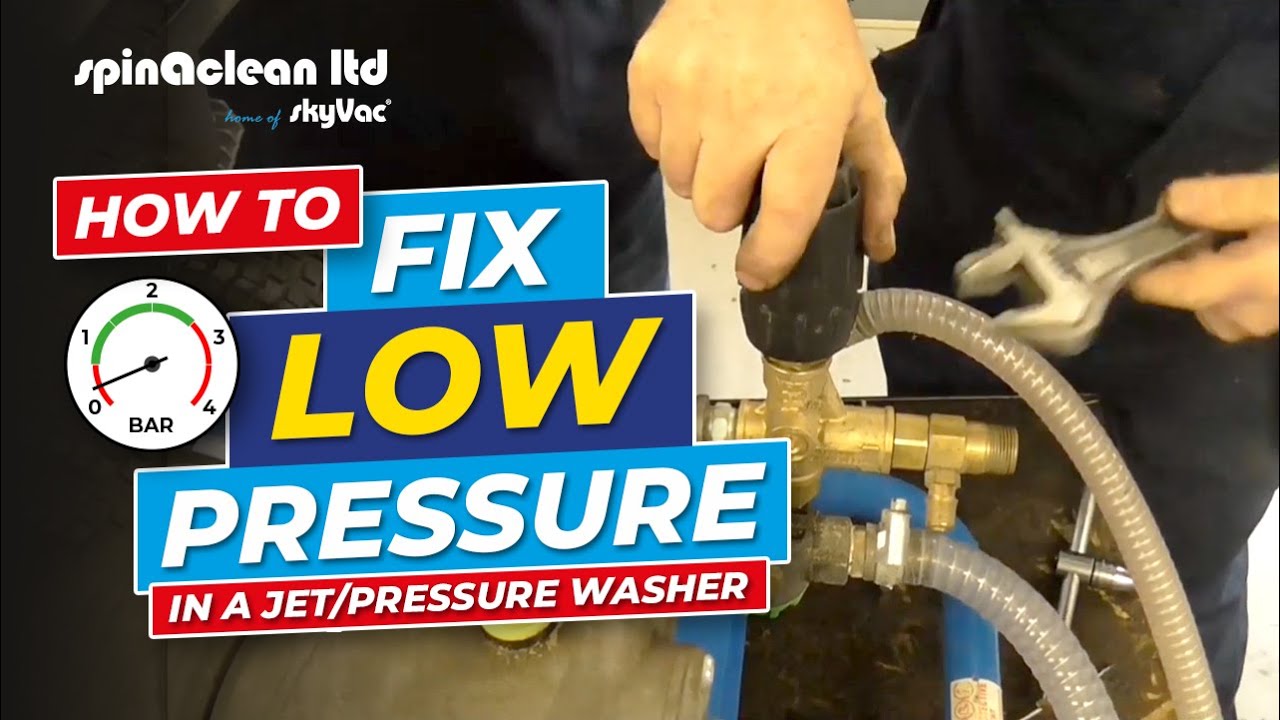Your pressure washer may have no pressure due to a clogged nozzle or a malfunctioning pump. Check for kinks in the hose or low water supply as well.
A pressure washer is a powerful tool that simplifies cleaning tasks, from driveways to decks. When it fails to generate pressure, frustration often follows. Understanding the common reasons behind this issue can save you time and effort. Regular maintenance is key to keeping your machine in optimal condition.
Problems can arise from various components, including the pump, hose, or nozzle. Diagnosing these issues promptly can restore your pressure washer’s performance. This guide will explore the typical causes of low pressure and provide tips for troubleshooting effectively, ensuring you get back to your cleaning tasks with ease.
Page Contents
Symptoms Of Low Pressure In Washers
Low pressure in a pressure washer can be frustrating. Identifying reduced pressure helps solve the problem quickly. Common signs include:
- Water flow is weak or barely noticeable.
- Pressure gauge shows low readings.
- Spray wand has inconsistent water spray.
- Cleaning performance is poor.
- Hoses and connections may leak.
Regular maintenance can prevent these issues. Check for clogs in the nozzle and filters. Ensure the water supply is adequate and the hoses are not kinked. These steps can help restore optimal pressure in your washer.

Credit: www.reddit.com
Initial Troubleshooting Steps
Before using a pressure washer, safety checks are crucial. Always wear safety goggles and gloves. Check for any damaged hoses or connections. Ensure the water supply is turned on and connected properly.
Inspect the power source. Make sure it is plugged in and working. Check the pressure settings on the machine. Look for any clogs in the nozzle or spray gun. A clean nozzle allows for better flow.
| Checklist | Status |
|---|---|
| Safety goggles | Worn |
| Hoses and connections | Checked |
| Water supply | On |
| Power source | Connected |
| Nozzle | Clean |
Water Supply Issues
Check for an adequate water source for your pressure washer. A weak supply can cause low pressure. Ensure that the water tap is fully open. Make sure the hoses are connected properly.
Look for kinks in the hoses. Kinks can block water flow. Straighten out any twists or bends. Replace any damaged hoses immediately. This will help restore proper pressure.

Credit: m.youtube.com
Pump Problems
Air locks can cause your pressure washer to lose pressure. These occur when air gets trapped in the pump. Clearing air locks is essential for proper function.
To clear air locks, follow these simple steps:
- Turn off the pressure washer.
- Disconnect the water supply.
- Point the spray wand into a bucket.
- Start the machine briefly to release air.
- Reconnect the water supply and restart.
Regular pump maintenance keeps your pressure washer working well. Check for leaks and tight connections. Clean filters and hoses to avoid clogs.
Replace worn-out parts when needed. Always follow the manufacturer’s guidelines for maintenance.
Nozzle Complications
Clogged nozzles can cause a loss of pressure in your pressure washer. Cleaning them is essential for proper function. Use a small needle or pin to clear debris from the nozzle tip. Soaking the nozzle in warm soapy water can also help remove dirt.
Choosing the right nozzle affects your pressure washer’s performance. Different tasks require different nozzles. For light cleaning, a 25-degree nozzle works well. For tougher jobs, use a 0-degree nozzle for a strong spray. Always match the nozzle size to your specific task for optimal results.
High-pressure Hose Hurdles
Inspect the high-pressure hose for any signs of leaks or damage. Small holes or cracks can lead to loss of pressure. Check the fittings and connections as well. Tighten any loose parts to prevent air from escaping.
Proper storage of the hose is essential. Avoid kinks and sharp bends. Storing it on a hose reel helps maintain its shape. Keep the hose away from extreme temperatures and sunlight. This prevents deterioration and extends its life.
Unloader Valve Adjustments
Adjusting the unloader valve is crucial for achieving the right pressure. Start by checking the pressure setting on the valve. Turn it clockwise to increase pressure or counterclockwise to reduce it. Always refer to your pressure washer manual for specific instructions.
Troubleshooting unloader valve issues can save time and money. Look for signs of leaks or damage. If the valve does not respond, it may need cleaning or replacement. Test the pressure after adjustments to ensure it is correct.
Common symptoms of a faulty unloader valve include low pressure or fluctuating pressure. Regular maintenance helps avoid these problems and keeps your pressure washer running smoothly.

Credit: www.reddit.com
Motor And Power Supply
Check the power supply first. Make sure the outlet works correctly. A faulty outlet can stop the motor.
Inspect the electric motor. Look for signs of wear and tear. A damaged motor can cause pressure issues.
For fuel engines, verify the fuel level. Low fuel can lead to power loss. Check the fuel lines for blockages.
Inspect the spark plug. A dirty or worn spark plug can affect performance. Clean or replace it if needed.
Examine the air filter. A clogged filter restricts airflow. Clean or replace it to improve engine efficiency.
Professional Intervention
Pressure washers can lose pressure for various reasons. Clogs, leaks, or faulty parts may be to blame. Identifying the issue can be tricky. Sometimes, a professional is needed for help.
Consider calling a technician if:
- The problem persists after basic troubleshooting.
- Parts need replacement but you lack the skills.
- You want to avoid further damage to the machine.
Weigh the costs of repairs against the benefits:
| Cost | Benefit |
|---|---|
| Repair costs can be high. | Professional repairs restore full functionality. |
| Replacement parts may add up. | Save time and effort with expert help. |
Preventive Measures
To keep your pressure washer in great shape, a routine maintenance schedule is essential. Check the oil level regularly. Change the oil as needed to ensure smooth operation.
Inspect the filters for clogs. Clean or replace them to maintain proper pressure. Examine the hoses for leaks or wear. Replace damaged hoses promptly to prevent pressure loss.
Store the pressure washer in a dry area. Avoid extreme temperatures that could damage parts. Use the right detergents to prevent buildup in the system.
Follow these best practices for longevity:
- Flush the system after each use.
- Use a water filter to catch debris.
- Keep the nozzle clean for optimal performance.
Frequently Asked Questions
Why Is My Pressure Washer Not Building Pressure?
A pressure washer may fail to build pressure due to a clogged nozzle, air leaks in the hose, or a malfunctioning pump. Regular maintenance can prevent these issues. Check for debris, tighten connections, and ensure the water supply is adequate to restore proper function.
What Causes Low Pressure In My Pressure Washer?
Low pressure can stem from several factors, including a dirty filter, worn-out seals, or insufficient water supply. Inspect the water inlet and clean the filter regularly. Replacing worn seals can also significantly improve pressure performance, ensuring effective cleaning.
How Do I Troubleshoot Pressure Loss?
Start by checking for clogs in the nozzle or hoses. Ensure that all connections are secure and that the water supply is consistent. If the problem persists, examine the pump for potential issues. Regular checks can help you identify problems early.
Can A Faulty Hose Affect Pressure?
Yes, a damaged or kinked hose can severely impact pressure. Ensure the hose is free from obstructions and not damaged. A good-quality hose is essential for optimal pressure delivery, so consider replacing it if you notice any significant wear or tear.
Conclusion
Experiencing low pressure in your pressure washer can be frustrating. Understanding the possible causes can help you troubleshoot effectively. Regular maintenance and proper setup are key to ensuring optimal performance. By addressing issues promptly, you can enjoy powerful cleaning results every time.
Keep your pressure washer in top shape for maximum efficiency.

